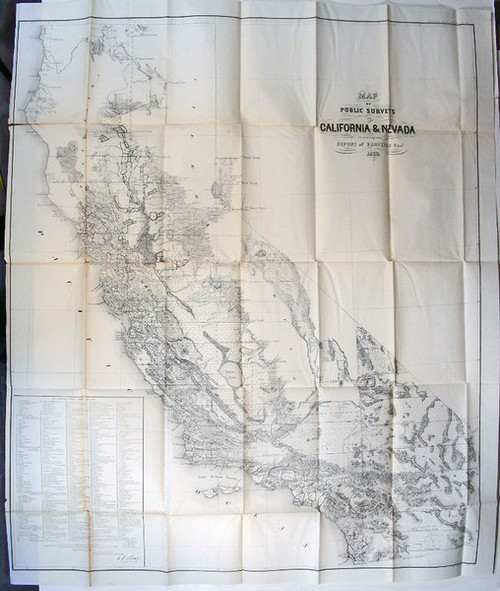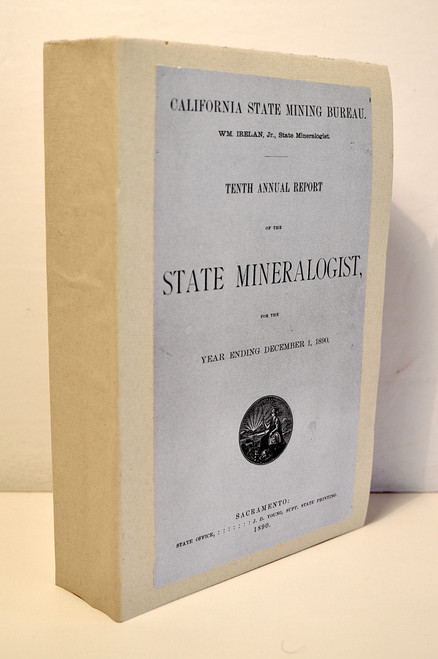Product Description
Powell, John Wesley; Report on the Lands of the Arid Region of the United States, with a More Detailed Account of the Lands of Utah, with Maps. Second Edition. Washington: GPO, 1879. Quarto, pp. xv, 195, 3 folded colored maps at rear and two additional maps in text.
The work is complete and in the original brown cloth re-backed with later brown cloth. Binding is tight, covers with light wear and scuffing. Text is clean, numerous notes on front end sheets where previous owner penciled notes on the historical significance of the work. The maps are clean with one having a very small stamp. The maps are in a clear acid free sleeve at the rear. The work is seldom seen with the three maps present. In very good condition.
John Wesley Powell (1834-1902) was an American geologist and professor, United States Army officer, explorer, and director of the USGS and other scientific institutions. He is best remembered for leading the 1869 three month scientific expedition down the Green and Colorado Rivers through the Grand Canyon.
Powell supported the abolishment of slavery and on the eve of the Civil War he enlisted in the US Army and was soon commissioned a 2nd Lieutenant. He was to lose his right arm at the Battle of Shiloh. He remained in the Army, was present at several battles and earned the rank of Major.
After leaving military service he became a professor of geology at Illinois Wesleyan University and also served as curator at the Illinois State Natural History Society where he greatly expanded the geological collections.
While Powell is remembered best for his scientific expeditions of the Grand Canyon, he also wished to see the western United States developed rationally due to the scarcity of water.
As second director of the USGS (1881-1894) he proposed a development plan for the arid regions of the western United States based on the arid climate of the region.
Powell’s knowledge of the geology, topography, and hydrology hydrology of the west led him to propose a plan for settling the arid West. Powell knew that the Homestead Act of 1862 which promised any citizen 160 acres of federal land if they settled on it and developed it was a recipe for failure in the arid regions. In 1878, Powell published his “Arid Regions” report and argued that 160 acres was too much land to give away if the land had water and too little if it did not. He wanted the federal government to set aside lands according to their resources. Lands located at high elevation would become timber lands; medium elevation would be grazing lands; and low elevation would be
farms. Powell also proposed that the watersheds of the American West should define the boundaries of new states. While well thought out the ideas were doomed. Speculators and shysters were threatened with the lose of what they considered fortunes if Congress passed the proposed bill and had it killed. Also when the irrigation survey began, the fear was that land speculation would run rampant in the hope that land values would rise because of the survey. The solution was for the Interior Department to withdraw western lands from purchase until the survey, which could take years, was completed. Meanwhile, prospects for Western development would languish. In a nutshell, Western water and land interests were fearful that Powell and his ideas would place a moratorium on Western development and reverse a century-long policy of the disposal of all of the public lands. A fear that continues to this day.
Government surveyors also set in Washington and drew straight lines on a map along swaths of country they had never visited and could not imagine contained the Sierra and the Rockies. Every state west of a line from North Dakota to Texas has a border that is a perfectly straight line. This included Wyoming and Colorado despite the presence of the Rocky Mountains.
While Powell lost the battle for determining state boundaries, and having a manageable plan put in place for the west, he did leave a surprising legacy. Powell’s ideas eventually shaped development of the West’s water supply. Most dams in the eastern half of the United States are privately owned. Powell’s knowledge of the West’s great canyons and rivers convinced him that only the federal government had the resources necessary to build the infrastructure needed for a western agricultural economy. Powell proposed that the federal government plan and control the water supply in the West. These ideas were put into use in the U.S. Bureau of Reclamation, which was created in 1902, the year that Powell died. Over the next 60 years, the bureau planned and supervised the construction of dams across the West, mostly at high elevations, and of irrigation systems, mostly at low elevations—just as Powell advocated.
Powell also predicted water shortages back in 1893 when he observed that the American West was “piling up a heritage of conflict and litigation over water rights, for there is not sufficient water to supply these lands.” The 20th century proved him right as the Colorado River Basin states fought each other over their share of water and continue to do so to this day as our drought continues. In 1934, Arizona called out the National Guard to block the construction of Parker Dam, which would divert water into California.
The the three folded maps found in the report are beautiful. They are:
1. Map of Utah territory : representing the extent of the irrigable, timber and pasture lands. Has additional note” Shows railroad, wagon road, telegraph lines, etc. Relief shown by hachures. Includes explanation, and Note: "This map has been constructed from atlas sheets of the U.S. Geographical and Geological Survey of the Rocky Mountain region with additional material taken from the maps of the U.S. Geographical Explorations and surveys west of the 100th meridian, Lieut. Geo. M. Wheeler, Corps of Engineers, in charge ; the U.S. Geological Exploration of the 40th parallel, Clarence King, U.S. Geologist in charge ; and the U.S. Geologial and Geographical Survey of the Territories, F.V. Hayden, in charge."
2. Rain chart of the United States : showing by isohyetal lines the distribution of the mean annual precipitation in rain and melted snow. This is a copy of the chart constructed for the Smithsonian Institution in 1868 by Charles A Schott.
3. Map of the United States exhibiting the grants of lands made by the general government to aid in the construction of railroads and wagon roads.
The first edition was sold out within a few months and this gave Powell and others an opportunity to revise the text, and correct a few errors.























